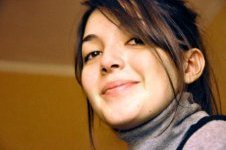Search
To search for an exact match, type the word or phrase you want in quotation marks.
A*DESK has been offering since 2002 contents about criticism and contemporary art. A*DESK has become consolidated thanks to all those who have believed in the project, all those who have followed us, debating, participating and collaborating. Many people have collaborated with A*DESK, and continue to do so. Their efforts, knowledge and belief in the project are what make it grow internationally. At A*DESK we have also generated work for over one hundred professionals in culture, from small collaborations with reviews and classes, to more prolonged and intense collaborations.
At A*DESK we believe in the need for free and universal access to culture and knowledge. We want to carry on being independent, remaining open to more ideas and opinions. If you believe in A*DESK, we need your backing to be able to continue. You can now participate in the project by supporting it. You can choose how much you want to contribute to the project.
You can decide how much you want to bring to the project.

This edition of ArtFutura 2012, the festival of Digital Culture and Creativity celebrated every year in various cities across the world, centres on a vital change of paradigm, with the slogan “our culture is digital”. This simple but forceful phrase sums up a complex cultural evolution. A process, which at the beginning implied a progressive digitalization, in order to constitute an alternative trend specific to the virtual world, that coexisted simultaneously with the remains of its analogical predecessor until reaching a stage of maturity, where the digital is the very essence of its nature.
From its beginnings in 1990, the festival has explored the international panorama of “new media”, interactive design, videogames and digital animation, to show that art and science share parallel paths. Now, 22 years later, the audio-visual programme continues to present examples of cultural demonstrations that are produced in an environment demarcated by the digital tools that make it possible. The programme presented this year in the CCCB in Barcelona includes examples of 3D animation, motion-graphics, time-lapse and special effects. Each one of these techniques represents a new form of creation that is capable of representing and inscribing itself within a society that changes at a breakneck speed. The movement and change in relation to space-time are intrinsic themes in the world of today, and consequently it’s not surprising that digital artistic practices explore these conceptual terrains.
The section “Just Lapsing Time” presents various pieces of time-lapse, a photographic technique considered by many to be the art of capturing time. If we take it for granted that culture now has to define itself as a process that isn´t static, made up of the flux of information, people and products that respond to dynamic relational models on a global scale, it is natural that an art arising out of this context tries to portray this extreme dynamism in an explicit manner.
By definition, time-lapse is the capturing of still images that afterwards are reproduced at a higher speed than the one with which they were taken, provoking the “effect of the accelerated image” characteristic of this photographic technique. Independently of whether one employs the method of recording a sequence with a video camera or if the images are captured with a digital camera, the process of creating time-lapse is obliged to pass through a specialised video-editing programme. Here the images are joined together to create a very short, accelerated video sequence, where the events portrayed for a set period of time, which can range from a few hours to several years, are reproduced at a much faster speed than is usual. So, as a form of cultural display produced in the environment created by the tools that make it reality, time-lapse’s existence is entirely dependent on technology, the new bits of equipment, digital cameras and video editing programmes, as well as the new recording techniques derived from them. Without these tools, it would be impossible to see in detail the frenetic movement of cities, as in the work of Dominic Boudreault “The City Limits”, the almost imperceptible changes in a human body, represented in the “Portrait of Lotte” by Frans Hofmeester, or the evolution of the natural environment, captured in “Sahara Wonderland” by Dennis Stauffer.
The essence of time-lapse is the manipulation of movement, or the dynamic flux that life presents, to make the passing of time visible. This modification, through the acceleration and intentional compression of time, exposes a new way of representing the onward thrust of life. A vision that breaks with the classical conception, in which it is impossible to perceive a large part of the changes suffered by our surroundings, and even in our own bodies, as they occur.
The pieces presented in ArtFutura 2012 show these changes, like the almost imperceptible alterations in the environment, reflected in “Night Skies” by T-Recs and the dynamic flux hidden behind the chaos of cities, analysed in “Points in Space” by Benjamin Ducroz. The result is the reflection of the passing of time and its effects, that manages to present the real rhythm of the world, almost invisible to the human eye but frenetic by nature, through a technique that manipulates it to create something coherent and beautiful.

Verónica Escobar Monsalve is a restless soul, with a digital nature and an analogue heart. Her investigations centre on art and culture that mix the digital world with pre-digital thought. Art and culture that is capable of reflecting the complexity of today’s world. She believes in the vital importance of a critical spirit and how this can be applied to any facet in life, however difficult it may be.
"A desk is a dangerous place from which to watch the world" (John Le Carré)